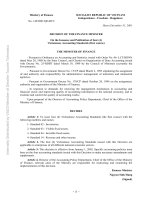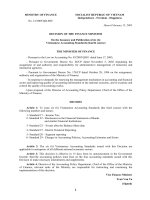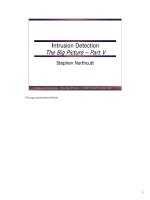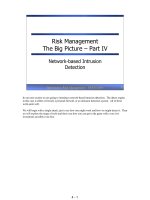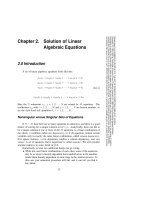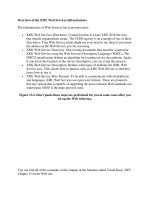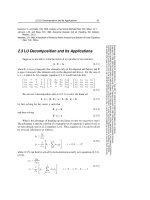Tài liệu Scene Of The Cybercrime Computer Forensics Handbook docx
Bạn đang xem bản rút gọn của tài liệu. Xem và tải ngay bản đầy đủ của tài liệu tại đây (5.81 MB, 754 trang )
With more than 1,500,000 copies of our MCSE, MCSD, CompTIA, and Cisco
study guides in print, we continue to look for ways we can better serve the
information needs of our readers. One way we do that is by listening.
Readers like yourself have been telling us they want an Internet-based ser-
vice that would extend and enhance the value of our books. Based on
reader feedback and our own strategic plan, we have created a Web site
that we hope will exceed your expectations.
is an interactive treasure trove of useful infor-
mation focusing on our book topics and related technologies. The site
offers the following features:
■
One-year warranty against content obsolescence due to vendor
product upgrades. You can access online updates for any affected
chapters.
■
“Ask the Author” customer query forms that enable you to post
questions to our authors and editors.
■
Exclusive monthly mailings in which our experts provide answers to
reader queries and clear explanations of complex material.
■
Regularly updated links to sites specially selected by our editors for
readers desiring additional reliable information on key topics.
Best of all, the book you’re now holding is your key to this amazing site.
Just go to www.syngress.com/solutions, and keep this book handy when
you register to verify your purchase.
Thank you for giving us the opportunity to serve your needs. And be sure
to let us know if there’s anything else we can do to help you get the
maximum value from your investment. We’re listening.
www.syngress.com/solutions
225_Cybercrime_FM.qxd 7/17/02 10:34 AM Page i
225_Cybercrime_FM.qxd 7/17/02 10:34 AM Page ii
Cybercrime
Scene of the
Computer Forensics Handbook
1 YEAR UPGRADE
BUYER PROTECTION PLAN
Debra Littlejohn Shinder
Ed Tittel
Technical Editor
225_Cybercrime_FM.qxd 7/17/02 10:34 AM Page iii
Syngress Publishing,Inc., the author(s), and any person or firm involved in the writing, editing, or
production (collectively “Makers”) of this book (“the Work”) do not guarantee or warrant the results
to be obtained from the Work.
There is no guarantee of any kind,expressed or implied,regarding the Work or its contents.The Work
is sold AS IS and WITHOUT WARRANTY.You may have other legal rights, which vary from state
to state.
In no event will Makers be liable to you for damages,including any loss of profits,lost savings, or
other incidental or consequential damages arising out from the Work or its contents.Because some
states do not allow the exclusion or limitation of liability for consequential or incidental damages,the
above limitation may not apply to you.
You should always use reasonable care,including backup and other appropriate precautions, when
working with computers, networks,data,and files.
Syngress Media®,Syngress®,“Career Advancement Through Skill Enhancement®,” and “Ask the
Author UPDATE®,”are registered trademarks of Syngress Publishing,Inc. “Mission Critical™,”“Hack
Proofing®,”and “The Only Way to Stop a Hacker is to Think Like One™” are trademarks of Syngress
Publishing,Inc. Brands and product names mentioned in this book are trademarks or service marks of
their respective companies.
KEY SERIAL NUMBER
001 JG9H7GYV83
002 R2UV7T5CVF
003 HJ9HFSCX3A
004 9MB76N679Y
005 U8NLT5R33S
006 X5L7NC4ES6
007 G8D4EB42AK
008 9BKMVC6RD7
009 SGWKP7V6FH
010 5BVFJJM39Z
PUBLISHED BY
Syngress Publishing,Inc.
800 Hingham Street
Rockland, MA 02370
Scene of the Cybercrime: Computer Forensics Handbook
Copyright © 2002 by Syngress Publishing,Inc.All rights reserved. Printed in the United States of
America. Except as permitted under the Copyright Act of 1976, no part of this publication may be
reproduced or distributed in any form or by any means, or stored in a database or retrieval system,
without the prior written permission of the publisher,with the exception that the program listings
may be entered,stored,and executed in a computer system, but they may not be reproduced for
publication.
Printed in the United States of America
1 2 3 4 5 6 7 8 9 0
ISBN: 1-931836-65-5
Technical Editor: Ed Tittel Cover Designer: Michael Kavish
Acquisitions Editor:Andrew Williams Page Layout and Art by: Personal Editions
Developmental Editor: Kate Glennon Copy Editor: Darlene Bordwell
Indexer: Claire A. Splan
Distributed by Publishers Group West in the United States and Jaguar Book Group in Canada.
225_Cybercrime_FM.qxd 7/17/02 10:34 AM Page iv
v
Acknowledgments
v
We would like to acknowledge the following people for their kindness and support
in making this book possible.
Richard Kristof and Duncan Anderson of Global Knowledge,for their generous
access to the IT industry’s best courses, instructors, and training facilities.
Ralph Troupe,Rhonda St. John,and the team at Callisma for their invaluable insight
into the challenges of designing, deploying and supporting world-class enterprise
networks.
Karen Cross, Lance Tilford, Meaghan Cunningham, Kim Wylie, Harry Kirchner,
Kevin Votel, Kent Anderson, Frida Yara, Bill Getz, Jon Mayes, John Mesjak, Peg
O’Donnell, Sandra Patterson, Betty Redmond, Roy Remer, Ron Shapiro, Patricia
Kelly,Andrea Tetrick, Jennifer Pascal, Doug Reil, and David Dahl of Publishers
Group West for sharing their incredible marketing experience and expertise.
Jacquie Shanahan,AnnHelen Lindeholm, David Burton, Febea Marinetti,and
Rosie Moss of Elsevier Science for making certain that our vision remains world-
wide in scope.
Annabel Dent and Paul Barry of Elsevier Science/Harcourt Australia for all
their help.
David Buckland,Wendi Wong, Marie Chieng, Lucy Chong, Leslie Lim,Audrey Gan,
and Joseph Chan of Transquest Publishers for the enthusiasm with which they receive
our books.
Kwon Sung June at Acorn Publishing for his support.
Jackie Gross,Gayle Voycey,Alexia Penny,Anik Robitaille, Craig Siddall, Darlene
Morrow, Iolanda Miller,Jane Mackay, and Marie Skelly at Jackie Gross & Associates
for all their help and enthusiasm representing our product in Canada.
Lois Fraser,Connie McMenemy, Shannon Russell and the rest of the great folks at
Jaguar Book Group for their help with distribution of Syngress books in Canada.
A special welcome to the folks at Woodslane in Australia! Thank you to David Scott
and everyone there as we start selling Syngress titles through Woodslane in Australia,
New Zealand,Papua New Guinea,Fiji Tonga,Solomon Islands, and the Cook Islands.
225_Cybercrime_FM.qxd 7/17/02 10:34 AM Page v
vi
Author Acknowledgments
and Dedications
It may or may not take a village to raise a child,but I know for sure that it takes a
whole network of people,across time and the globe,to bring a book like this one
into being.An author,like a parent,feels a certain proprietary investment in the final
product—but I couldn’t have done it alone,and I’m glad I didn’t have to.
This book is the culmination of three separate but intertwined vocations I’ve
pursued during my life:law enforcement, computer networking (a.k.a. IT), and
writing.They say that in the end,the last shall be first, and that was and is true for
me.To be a professional writer was one of my first aspirations, way back in eighth
grade when I scrawled my first (badly written but somewhat complete) 300-page
novel on notebook paper and loaned it out to friends like a one-person library.I
went on to write for and edit my high school and college newspapers, and the
teachers and friends who encouraged my ambitions back then deserve the first
debt of gratitude: Bobbie Ferguson, Michael Britton, and Barbara Gifford Brown—
wherever you are now, thank you.
I never gave up that dream,but the kind of writing I was doing early on didn’t
pay the bills, so I followed in my father’s footsteps into government work,and ended
up falling in love with law enforcement and following that path for the third decade
of my life.Without my experience as a police officer and police academy instructor,
this would be just another tech book,so I want to thank some of those who made all
that possible:Larry Beckett, Sarah Whitaker, Danny Price,Marty Imwalle,Mike
Walker, Patt Scheckel-Hollingsworth, Lin Kirk Jones,and Neal Wilson.
I enjoyed being a cop, but as I got older,I found there was something else I
enjoyed even more—and it was easier on the body and paid better,to boot. I’d been
a computer hobbyist for a long time (my old VIC-20 and Commodore 64 are still
here on a high shelf in the closet) and after meeting my husband online,together we
set up our home network and studied together to become MCSEs.He was as tired
of medicine as I was of police work,and when it came time for us to look for a new
career we could share,the solution was obvious.The tech world beckoned.We did
consulting for a while, and then started teaching.There were many who helped us
along the way:Cash Traylor, Johnnie and Irene at Eastfield,Thomas Lee and everyone
225_Cybercrime_FM.qxd 7/17/02 10:34 AM Page vi
vii
on the Saluki list, David (Darkcat) Smith and the gang at DigitalThink, Donna Gang
at Technology Partners, and all our students in the MCSE programs.
Through it all, writing was still my secret passion.When the opportunity arose to
author tech books, it seemed that my life had come full circle.For providing that
opportunity, I have to thank the folks at Syngress and Dave Dusthimer at Cisco Press.
Many people contributed to the success of my and Tom’s writing careers, especially
Julie,Maribeth, Kitty,Carl, our tech editors,and most of all, the readers who bought
the books.
Which brings us to this book. I had a huge amount of input and assistance from
many corners, all of which added value and made writing it easier and more fun:
Andrew Williams,who made it possible; James Michael Stewart, without whose
contributions to Chapters 8 and 9 this book would not have been finished on time;
“Tech Ed”Tittel and Developmental Editor Kate Glennon, whose comments and
questions kept me on my toes.I also want to thank David Rhoades of Maven
Security,for the information about “click kiddies,”and all the law enforcement
officers who shared their experiences and cybercrime expertise,especially Wes Edens,
Glen Klinkhart,Dave Pettinari,Troy Lawrence,Bryan Blake,Dean Scoville,Robert
Bell, Bud Levin and Robert S. Baldygo,James Rogers, Bob Foy, Michael J.West,Tom
Burns, and Ira Wilsker.
Finally (and the first shall be last), there were the friends and family members
who provided encouragement all along the way.This book is dedicated to Tom (my
husband, best friend, and business partner,who also wrote part of the section on
name resolution in Chapter 5),Kris and Kniki (the two best kids in the world),
Mom, Dad (whom I still miss every day),Jeff Tharp (one of the few friends who
really did keep in touch after he moved away), all the Piglets (especially Bob, Lash,
Dee, Robert, Shawn, bud, the Buerger King, Chief Al, MikeO and “Ms.V,Wherever
You Are”),the MarketChat gang, the Storytalkers, the Writingchatters and all the
rodents of unusual sizes on the CBP and related lists.
—Debra Littlejohn Shinder
225_Cybercrime_FM.qxd 7/17/02 10:34 AM Page vii
Author
Debra Littlejohn Shinder is a former Police Sergeant and Police
Academy Instructor, turned IT professional. She and her husband, Dr.
Thomas W. Shinder, have provided network consulting services to busi-
nesses and municipalities,conducted training at colleges and technical
training centers, and spoken at seminars around the country. Deb special-
izes in networking and security, and she and Tom have written numerous
books, including the best selling Configuring ISA Server 2000 (Syngress
Publishing,ISBN: 1-928994-29-6), and Deb is the sole author of
Computer Networking Essentials. Deb also is the author of over 100 articles
for print publications and electronic magazines such as TechProGuild,
CNET, 8Wire, and Cramsession. Deb is a member of the editorial board of
the Journal of Police Crisis Negotiations and the advisory board of the
Eastfield College Criminal Justice Training Center.
225_Cybercrime_FM.qxd 7/17/02 10:34 AM Page viii
ix
Ed Tittel is a 20-year veteran of the computing industry who has
worked as a programmer, systems engineer,technical manager, writer,
consultant, and trainer.A contributor to over 100 computer books, Ed
created the Exam Cram series of certification guides. Ed also writes
for numerous Web sites and magazines on certification topics including
InformIT.com,Certification and IT Contractor magazines,and numerous
TechTarget venues (www.searchsecurity.com,www.searchnetworking.com,
www.searchWin2000.com,www.searchWebManagement.com).When
he’s not busy writing, researching,or teaching, Ed likes to shoot pool,
consume the occasional glass of red wine, and walk his Labrador retriever,
Blackie.
James Michael Stewart (MCSE, CCNA, CISSP,TICSA, CIW Security
Analyst) is a writer,researcher,and trainer who specializes in IT security
and networking related certification topics.A contributor to over 75
books, Michael has most recently contributed to titles on CISSP,TICSA,
Windows 2000, and Windows XP topics. Michael also teaches for
NetWorld + Interop twice yearly, where he offers courses on Windows
security and on Windows performance optimization and tuning. In his
spare time, Michael is an avid handyman,waterskier,world traveler, and a
dancin’ fool (primarily the two-step).
Michael Cross (MCSE, MCP+I, CNA, Network+) is an Internet
Specialist and Programmer with the Niagara Regional Police Service
and has also served as their Network Administrator. Michael performs
Technical Editor and Contributor
Contributors
225_Cybercrime_FM.qxd 7/17/02 10:34 AM Page ix
x
computer forensic examinations of computers involved in criminal inves-
tigations, and has consulted and assisted in cases dealing with computer-
related/Internet crimes. He is responsible for designing and maintaining
their Web site at www.nrps.com, and two versions of their Intranet (one
used by workstations,and another accessed through patrol vehicles). He
programs applications used by various units of the Police Service,has
been responsible for network security and administration, and continues
to assist in this regard.Michael is part of an Information Technology team
that provides support to a user base of over 800 civilian and uniform
users. His theory is that when the users carry guns,you tend to be more
motivated in solving their problems.
Previous to working for the Niagara Regional Police Service, Michael
worked as an instructor for private colleges and technical schools in
London, Ontario,Canada. It was during this period that he was recruited
as a writer for Syngress Publishing,and became a regular member of
their writing team. Michael also owns KnightWare,a company that
provides Web page design and other services. He currently resides in
St. Catharines, Ontario Canada, with his lovely wife,Jennifer.
225_Cybercrime_FM.qxd 7/17/02 10:34 AM Page x
Contents
xi
Foreword xxv
Chapter 1 Facing the Cybercrime Problem Head On 1
Introduction 2
Quantifying the Crisis 3
Defining Cybercrime 4
Moving from the General to the Specific 5
Understanding the Importance of Jurisdictional Issues 6
Differentiating Crimes That Use the Net from Crimes That
Depend on the Net 10
Collecting Statistical Data on Cybercrime 11
Understanding the Crime Reporting System 11
Categorizing Crimes for the National Reporting System 13
Toward a Working Definition of Cybercrime 15
U.S. Federal and State Statutes 15
International Law:The United Nations Definition of
Cybercrime 17
Categorizing Cybercrime 18
Developing Categories of Cybercrimes 19
Violent or Potentially Violent Cybercrime Categories 19
Nonviolent Cybercrime Categories 23
Prioritizing Cybercrime Enforcement 33
Fighting Cybercrime 35
Determining Who Will Fight Cybercrime 35
Educating Cybercrime Fighters 37
Educating Legislators and Criminal Justice Professionals 38
Educating Information Technology Professionals 39
Educating and Engaging the Community 41
225_Cybercrime_Contents 7/17/02 11:14 AM Page xi
xii Contents
Getting Creative in the Fight Against Cybercrime 41
Using Peer Pressure to Fight Cybercrime 42
Using Technology to Fight Cybercrime 43
Finding New Ways to Protect Against Cybercrime 44
Summary 45
Frequently Asked Questions 46
Resources 47
Chapter 2 Reviewing the History of Cybercrime 49
Introduction 50
Exploring Criminality in the Days of Standalone Computers 51
Sharing More Than Time 52
The Evolution of a Word 52
Understanding Early Phreakers, Hackers,and Crackers 53
Hacking Ma Bell’s Phone Network 53
Phamous Phreakers 54
Phreaking on the Other Side of the Atlantic 54
A Box for Every Color Scheme 54
From Phreaker to Hacker 55
Living on the LAN:Early Computer Network Hackers 55
How BBSs Fostered Criminal Behavior 56
How Online Services Made Cybercrime Easy 57
Introducing the ARPANet:: the Wild West of Networking 58
Sputnik Inspires ARPA 59
ARPA Turns Its Talents to Computer Technology 59
Network Applications Come into Their Own 60
The Internetwork Continues to Expand 60
The ARPANet of the 1980s 60
The Internet of the 1990s 60
The Worm Turns—and Security Becomes a Concern 61
Watching Crime Rise with the Commercialization of the Internet 61
Bringing the Cybercrime Story Up to Date 62
Understanding How New Technologies Create New
Vulnerabilities 62
Why Cybercriminals Love Broadband 63
Why Cybercriminals Love Wireless 67
Why Cybercriminals Love Mobile Computing 72
Why Cybercriminals Love Sophisticated Web and
E-Mail Technologies 75
225_Cybercrime_Contents 7/17/02 11:14 AM Page xii
Contents xiii
Why Cybercriminals Love E-Commerce and
Online Banking 80
Why Cybercriminals Love Instant Messaging 84
Why Cybercriminals Love New Operating Systems and
Applications 87
Why Cybercriminals Love Standardization 87
Planning for the Future:How to Thwart Tomorrow’s
Cybercriminal 88
Summary 89
Frequently Asked Questions 90
Resources 91
Chapter 3 Understanding the People on the Scene 93
Introduction 94
Understanding Cybercriminals 96
Profiling Cybercriminals 98
Understanding How Profiling Works 99
Reexamining Myths and Misconceptions
About Cybercriminals 102
Constructing a Profile of the Typical Cybercriminal 111
Recognizing Criminal Motivations 112
Recognizing the Limitations of Statistical Analysis 119
Categorizing Cybercriminals 119
Criminals Who Use the Net as a Tool of the Crime 120
Criminals Who Use the Net Incidentially to the Crime 127
Real-Life Noncriminals Who Commit Crimes Online 128
Understanding Cybervictims 129
Categorizing Victims of Cybercrime 130
Making the Victim Part of the Crime-Fighting Team 134
Understanding Cyberinvestigators 136
Recognizing the Characteristics of a Good
Cyberinvestigator 136
Categorizing Cyberinvestigators by Skill Set 138
Recruiting and Training Cyberinvestigators 139
Facilitating Cooperation: CEOs on the Scene 140
Summary 142
Frequently Asked Questions 143
Resources 145
225_Cybercrime_Contents 7/17/02 11:14 AM Page xiii
xiv Contents
Chapter 4 Understanding Computer Basics 147
Introduction 148
Understanding Computer Hardware 149
Looking Inside the Machine 150
Components of a Digital Computer 150
The Role of the Motherboard 151
The Roles of the Processor and Memory 153
The Role of Storage Media 157
Why This Matters to the Investigator 163
The Language of the Machine 164
Wandering Through a World of Numbers 165
Who’s on Which Base? 165
Understanding the Binary Numbering System 166
Converting Between Binary and Decimal 167
Converting Between Binary and Hexadecimal 167
Converting Text to Binary 168
Encoding Nontext Files 169
Why This Matters to the Investigator 169
Understanding Computer Operating Systems 171
Understanding the Role of the Operating System Software 172
Differentiating Between Multitasking and
Multiprocessing Types 173
Multitasking 173
Multiprocessing 174
Differentiating Between Proprietary and Open Source
Operating Systems 175
An Overview of Commonly Used Operating Systems 177
Understanding DOS 177
Windows 1.x Through 3.x 179
Windows 9x (95, 95b,95c, 98, 98SE,and ME) 181
Windows NT 183
Windows 2000 185
Windows XP 186
Linux/UNIX 188
Other Operating Systems 190
Understanding File Systems 193
FAT12 193
FAT16 194
225_Cybercrime_Contents 7/17/02 11:14 AM Page xiv
Contents xv
VFAT 194
FAT32 194
NTFS 195
Other File Systems 196
Summary 197
Frequently Asked Questions 198
Resources 199
Chapter 5 Understanding Networking Basics 201
Introduction 202
Understanding How Computers Communicate on a Network 203
Sending Bits and Bytes Across a Network 204
Digital and Analog Signaling Methods 205
How Multiplexing Works 207
Directional Factors 208
Timing Factors 209
Signal Interference 210
Packets,Segments, Datagrams, and Frames 211
Access Control Methods 212
Network Types and Topologies 213
Why This Matters to the Investigator 215
Understanding Networking Models and Standards 215
The OSI Networking Model 216
The DoD Networking Model 218
The Physical/Data Link Layer Standards 220
Why This Matters to the Investigator 220
Understanding Network Hardware 221
The Role of the NIC 221
The Role of the Network Media 221
The Roles of Network Connectivity Devices 223
Why This Matters to the Investigator 231
Understanding Network Software 231
Understanding Client/Server Computing 232
Server Software 235
Client Software 236
Network File Systems and File Sharing Protocols 237
A Matter of (Networking) Protocol 238
Understanding the TCP/IP Protocols Used on the Internet 240
225_Cybercrime_Contents 7/17/02 11:14 AM Page xv
xvi Contents
The Need for Standardized Protocols 240
A Brief History of TCP/IP 241
The Internet Protocol and IP Addressing 242
How Routing Works 249
The Transport Layer Protocols 254
The MAC Address 257
Name Resolution 257
TCP/IP Utilities 263
Network Monitoring Tools 269
Why This Matters to the Investigator 272
Summary 273
Frequently Asked Questions 274
Resources 277
Chapter 6 Understanding Network Intrusions and Attacks 279
Introduction 280
Understanding Network Intrusions and Attacks 282
Intrusions vs.Attacks 283
Recognizing Direct vs.Distributed Attacks 284
Automated Attacks 286
Accidental “Attacks” 287
Preventing Intentional Internal Security Breaches 288
Preventing Unauthorized External Intrusions 289
Planning for Firewall Failures 290
External Intruders with Internal Access 290
Recognizing the “Fact of the Attack” 291
Identifying and Categorizing Attack Types 292
Recognizing Pre-intrusion/Attack Activities 292
Port Scans 294
Address Spoofing 297
IP Spoofing 298
ARP Spoofing 298
DNS Spoofing 299
Placement of Trojans 300
Placement of Tracking Devices and Software 300
Placement of Packet Capture and Protocol Analyzer Software 302
Prevention and Response 304
Understanding Password Cracking 305
225_Cybercrime_Contents 7/17/02 11:14 AM Page xvi
Contents xvii
Brute Force 306
Exploitation of Stored Passwords 309
Interception of Passwords 311
Password Decryption Software 312
Social Engineering 313
Prevention and Response 314
General Password Protection Measures 314
Protecting the Network Against Social Engineers 315
Understanding Technical Exploits 315
Protocol Exploits 316
DoS Attacks That Exploit TCP/IP 316
Source Routing Attacks 323
Other Protocol Exploits 324
Application Exploits 324
Bug Exploits 324
Mail Bombs 325
Browser Exploits 325
Web Server Exploits 327
Buffer Overflows 328
Operating System Exploits 329
The WinNuke Out-of-Band Attack 329
Windows Registry Attacks 329
Other Windows Exploits 330
UNIX Exploits 331
Router Exploits 332
Prevention and Response 333
Attacking with Trojans,Viruses, and Worms 334
Trojans 336
Viruses 337
Worms 338
Prevention and Response 339
Hacking for Nontechies 340
The Script Kiddie Phenomenon 340
The “Point and Click” Hacker 341
Prevention and Response 342
Summary 343
Frequently Asked Questions 344
Resources 346
225_Cybercrime_Contents 7/17/02 11:14 AM Page xvii
xviii Contents
Chapter 7 Understanding Cybercrime Prevention 349
Introduction 350
Understanding Network Security Concepts 351
Applying Security Planning Basics 352
Defining Security 352
The Importance of Multilayered Security 353
The Intrusion Triangle 353
Removing Intrusion Opportunities 354
Talking the Talk: Security Terminology 355
Importance of Physical Security 357
Protecting the Servers 359
Keeping Workstations Secure 359
Protecting Network Devices 360
Understanding Basic Cryptography Concepts 364
Understanding the Purposes of Cryptographic Security 364
Authenticating Identity 366
Providing Confidentiality of Data 372
Ensuring Data Integrity 372
Basic Cryptography Concepts 373
Scrambling Text with Codes and Ciphers 373
What Is Encryption? 376
Securing Data with Cryptographic Algorithms 378
How Encryption Is Used in Information Security 380
What Is Steganography? 384
Modern Decryption Methods 385
Cybercriminals’Use of Encryption and Steganography 386
Making the Most of Hardware and Software Security 387
Implementing Hardware-Based Security 387
Hardware-Based Firewalls 387
Authentication Devices 388
Implementing Software-Based Security 391
Cryptographic Software 391
Digital Certificates 392
The Public Key Infrastructure 392
Software-Based Firewalls 393
Understanding Firewalls 394
How Firewalls Use Layered Filtering 395
225_Cybercrime_Contents 7/17/02 11:14 AM Page xviii
Contents xix
Packet Filtering 395
Circuit Filtering 396
Application Filtering 397
Integrated Intrusion Detection 398
Forming an Incident Response Team 398
Designing and Implementing Security Policies 401
Understanding Policy-Based Security 401
What Is a Security Policy? 402
Why This Matters to the Investigator 403
Evaluating Security Needs 404
Components of an Organizational Security Plan 404
Defining Areas of Responsibility 404
Analyzing Risk Factors 406
Assessing Threats and Threat Levels 407
Analyzing Organizational and Network Vulnerabilities 409
Analyzing Organizational Factors 412
Considering Legal Factors 413
Analyzing Cost Factors 413
Assessing Security Solutions 414
Complying with Security Standards 415
Government Security Ratings 415
Utilizing Model Policies 416
Defining Policy Areas 417
Password Policies 417
Other Common Policy Areas 420
Developing the Policy Document 421
Establishing Scope and Priorities 422
Policy Development Guidelines 422
Policy Document Organization 423
Educating Network Users on Security Issues 425
Policy Enforcement 425
Policy Dissemination 426
Ongoing Assessment and Policy Update 426
Summary 427
Frequently Asked Questions 428
Resources 430
225_Cybercrime_Contents 7/17/02 11:14 AM Page xix
xx Contents
Chapter 8 Implementing System Security 431
Introduction 432
How Can Systems Be Secured? 433
The Security Mentality 433
Elements of System Security 435
Implementing Broadband Security Measures 436
Broadband Security Issues 439
Deploying Antivirus Software 441
Defining Strong User Passwords 444
Setting Access Permissions 444
Disabling File and Print Sharing 445
Using NAT 446
Deploying a Firewall 448
Disabling Unneeded Services 449
Configuring System Auditing 449
Implementing Browser and E-Mail Security 452
Types of Dangerous Code 454
JavaScript 454
ActiveX 455
Java 455
Making Browsers and E-Mail Clients More Secure 456
Restricting Programming Languages 456
Keep Security Patches Current 457
Cookie Awareness 457
Securing Web Browser Software 458
Securing Microsoft Internet Explorer 458
Securing Netscape Navigator 462
Securing Opera 464
Implementing Web Server Security 465
DMZ vs. Stronghold 466
Isolating the Web Server 467
Web Server Lockdown 468
Managing Access Control 468
Handling Directory and Data Structures 468
Scripting Vulnerabilities 469
Logging Activity 470
Backups 470
225_Cybercrime_Contents 7/17/02 11:14 AM Page xx
Contents xxi
Maintaining Integrity 470
Rogue Web Servers 471
Understanding Security and Microsoft Operating Systems 471
General Microsoft Security Issues 472
NetBIOS 472
Widespread Automated Functionality 473
IRDP Vulnerability 474
NIC Bindings 474
Securing Windows 9x Computers 475
Securing a Windows NT 4.0 Network 478
Securing a Windows 2000 Network 481
Windows .NET:The Future of Windows Security 483
Understanding Security and UNIX/Linux Operating Systems 483
Understanding Security and Macintosh Operating Systems 487
Understanding Mainframe Security 489
Understanding Wireless Security 490
Summary 493
Frequently Asked Questions 494
Resources 495
Chapter 9 Implementing Cybercrime Detection Techniques 499
Introduction 500
Security Auditing and Log Files 502
Auditing for Windows Platforms 503
Auditing for UNIX and Linux Platforms 508
Firewall Logs,Reports,Alarms, and Alerts 510
Understanding E-Mail Headers 516
Tracing a Domain Name or IP Address 522
Commercial Intrusion Detection Systems 524
Characterizing Intrusion Detection Systems 525
Commercial IDS Players 530
IP Spoofing and Other Antidetection Tactics 532
Honeypots,Honeynets,and Other “Cyberstings” 533
Summary 536
Frequently Asked Questions 539
Resources 542
225_Cybercrime_Contents 7/17/02 11:14 AM Page xxi
xxii Contents
Chapter 10 Collecting and Preserving Digital Evidence 545
Introduction 546
Understanding the Role of Evidence in a Criminal Case 548
Defining Evidence 549
Admissibility of Evidence 551
Forensic Examination Standards 552
Collecting Digital Evidence 552
The Role of First Responders 553
The Role of Investigators 554
The Role of Crime Scene Technicians 555
Preserving Digital Evidence 558
Preserving Volatile Data 559
Disk Imaging 560
A History of Disk Imaging 560
Imaging Software 561
Standalone Imaging Tools 563
Role of Imaging in Computer Forensics 563
“Snapshot”Tools and File Copying 563
Special Considerations 564
Environmental Factors 564
Retaining Time and Datestamps 565
Preserving Data on PDAs and Handheld Computers 565
Recovering Digital Evidence 566
Recovering “Deleted” and “Erased” Data 567
Decrypting Encrypted Data 568
Finding Hidden Data 568
Where Data Hides 569
Detecting Steganographic Data 569
Alternate Datastreams 570
Methods for Hiding Files 571
The Recycle Bin 572
Locating Forgotten Evidence 572
Web Caches and URL Histories 572
Temp Files 574
Swap and Page Files 575
Recovering Data from Backups 577
225_Cybercrime_Contents 7/17/02 11:14 AM Page xxii
Contents xxiii
Defeating Data Recovery Techniques 578
Overwriting the Disk 579
Degaussing or Demagnetizing 580
Physically Destroying the Disk 580
Documenting Evidence 581
Evidence Tagging and Marking 581
Evidence Logs 581
Documenting Evidence Analysis 582
Documenting the Chain of Custody 583
Computer Forensics Resources 583
Computer Forensics Training and Certification 584
Computer Forensics Equipment and Software 585
Computer Forensics Services 586
Computer Forensics Information 587
Understanding Legal Issues 587
Searching and Seizing Digital Evidence 588
U.S. Constitutional Issues 589
Search Warrant Requirements 591
Search Without Warrant 594
Seizure of Digital Evidence 597
Forfeiture Laws 598
Privacy Laws 598
The Effects of the U.S. Patriot Act 599
Summary 602
Frequently Asked Questions 603
Resources 605
Chapter 11 Building the Cybercrime Case 607
Introduction 608
Major Factors Complicating Prosecution 609
Difficulty of Defining the Crime 609
Bodies of Law 610
Types of Law 616
Levels of Law 618
Basic Criminal Justice Theory 620
Elements of the Offense 624
Level and Burden of Proof 625
225_Cybercrime_Contents 7/17/02 11:14 AM Page xxiii
xxiv Contents
Jurisdictional Issues 626
Defining Jurisdiction 626
Statutory Law Pertaining to Jurisdiction 629
Case Law Pertaining to Jurisdiction 630
International Complications 631
Practical Considerations 631
The Nature of the Evidence 632
Human Factors 633
Law Enforcement “Attitude” 633
The High-Tech Lifestyle 635
Natural-Born Adversaries? 635
Overcoming Obstacles to Effective Prosecution 636
The Investigative Process 637
Investigative Tools 639
Steps in an Investigation 646
Defining Areas of Responsibility 650
Testifying in a Cybercrime Case 650
The Trial Process 651
Testifying as an Evidentiary Witness 652
Testifying as an Expert Witness 652
Giving Direct Testimony 653
Cross-Examination Tactics 654
Using Notes and Visual Aids 654
Summary 656
Frequently Asked Questions 657
Resources 658
Afterword 659
Appendix 663
Index 699
225_Cybercrime_Contents 7/17/02 11:14 AM Page xxiv

